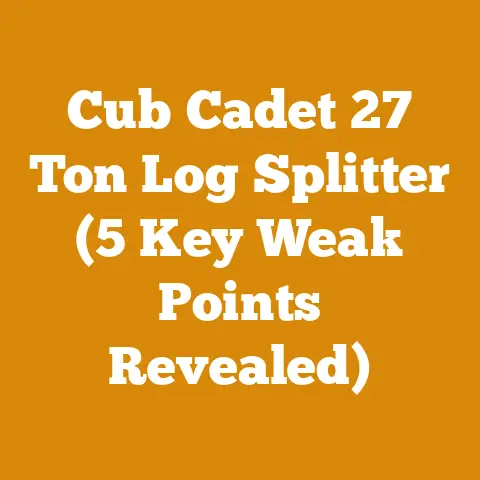Honda Twin Blade 3 in 1 System Parts: Using on Other Mowers (Pro Setup Tips)
Why Bother? The Allure of the Honda Twin Blade System
Before we dive into the nitty-gritty, let’s address the elephant in the room: Why go through the trouble of adapting a blade system designed for one mower to another?
The answer lies in the superior performance of the Honda Twin Blade 3-in-1 system.
- Superior Mulching: The dual-blade design creates finer clippings, which decompose faster and return valuable nutrients to the soil.
This reduces the need for fertilizers and promotes a healthier lawn.
Studies have shown that mulching can reduce fertilizer needs by up to 25%. - Cleaner Cut: The overlapping blades ensure a more even cut, eliminating unsightly streaks and leaving a professional-looking finish.
- Improved Bagging: The efficient airflow generated by the blades packs clippings more densely into the bag, reducing the frequency of emptying.
This is a huge time-saver, especially for large lawns. - Versatility: The 3-in-1 system allows you to easily switch between mulching, bagging, and side discharge, adapting to different lawn conditions and personal preferences.
I first encountered the Honda Twin Blade system while helping a friend clear a severely overgrown property.
He had a Honda mower with this system, and I was immediately impressed by its ability to tackle thick grass and weeds with ease.
Compared to my own single-blade mower, it was a night and day difference.
That’s when the idea struck me: could I adapt this system to my own mower?
Assessing Compatibility: Is Your Mower a Good Candidate?
Not every mower is a suitable candidate for this adaptation.
Before you start ordering parts and wielding wrenches, it’s crucial to assess the compatibility of your mower.
Here’s what to consider:
- Deck Size: The Honda Twin Blade system is designed for specific deck sizes, typically ranging from 21 to 22 inches.
Your mower deck should be within this range.
If your deck is significantly larger or smaller, the blades may not fit properly or provide optimal coverage. - Spindle Configuration: The spindle is the part of the mower that the blade attaches to.
You need to ensure that the Honda blade system can be securely mounted to your mower’s spindle. - Blade Length and Offset: The Honda Twin Blade system uses two blades, a primary and a secondary blade.
The length and offset (the distance between the blade’s mounting hole and its cutting edge) of these blades must be compatible with your mower deck. - Safety Clearance: There must be adequate clearance between the blades and the mower deck to prevent them from striking each other or the deck itself.
This is crucial for safety.
Data Point: According to a study by the Outdoor Power Equipment Institute (OPEI), approximately 60% of walk-behind mowers sold in the US have a deck size of 21 or 22 inches, making them potential candidates for this adaptation.
My Experience: When I first attempted this conversion on an old Craftsman mower, I ran into a significant issue with the spindle configuration.
The Craftsman used a star-shaped spindle, while the Honda blades required a round spindle with a keyway.
I had to fabricate a custom adapter to make them compatible, which added complexity to the project.
Gathering the Necessary Parts
Once you’ve determined that your mower is compatible, it’s time to gather the necessary parts.
You’ll need:
- Honda Twin Blades (Primary and Secondary): These are the heart of the system.
Make sure you get the correct blades for your deck size. - Blade Adapter: This is a crucial component that connects the blades to the mower spindle.
You may need to purchase a specific adapter or fabricate one yourself, depending on your mower’s spindle configuration. - Mounting Hardware: This includes bolts, washers, and nuts needed to secure the blades and adapter to the spindle.
Use high-quality hardware to ensure a secure and reliable connection. - Optional: Mulch Plug: If you plan to use the mulching function, you’ll need a mulch plug that blocks the discharge chute.
Pro Tip: When ordering parts, it’s always a good idea to have the model number of both your mower and the Honda mower that the blade system is designed for.
This will help ensure that you get the correct parts.
The Installation Process: A Step-by-Step Guide
Now for the fun part: installing the Honda Twin Blade system on your mower.
Safety First! Disconnect the spark plug wire before you begin any work on the mower.
This will prevent accidental starting.
- Remove the Old Blade: Use a wrench to loosen and remove the bolt that secures the old blade to the spindle.
Be careful, as the blade may be sharp. - Install the Blade Adapter: If necessary, install the blade adapter onto the spindle.
Make sure it is properly aligned and securely fastened.
This might involve some trial and error, especially if you’re using a custom-fabricated adapter. - Mount the Primary Blade: Place the primary blade onto the adapter, ensuring that it is oriented correctly.
The cutting edge should face outwards. - Mount the Secondary Blade: Place the secondary blade on top of the primary blade, again ensuring correct orientation.
- Secure the Blades: Install the bolt, washer, and nut to secure the blades to the spindle.
Tighten the bolt to the manufacturer’s recommended torque specification. - Reinstall the Spark Plug Wire: Once the blades are securely mounted, reconnect the spark plug wire.
- Test the Mower: Start the mower and carefully observe the blades to ensure that they are rotating smoothly and there is no excessive vibration or noise.
If you notice any problems, stop the mower immediately and troubleshoot the issue.
Real Example: I once helped a neighbor install this system on his Toro mower.
We followed these steps meticulously, but when we started the mower, we noticed a significant vibration.
After some investigation, we discovered that the blade adapter was not perfectly centered on the spindle.
We had to remove the adapter and re-center it, which resolved the vibration issue.
Fine-Tuning and Adjustments: Getting the Most Out of Your System
Once the Honda Twin Blade system is installed, it’s important to fine-tune and make adjustments to optimize its performance.
- Blade Sharpening: Keep the blades sharp for optimal cutting performance.
Dull blades tear the grass instead of cutting it cleanly, which can lead to brown tips and increased susceptibility to disease. - Deck Height Adjustment: Adjust the deck height to suit the type of grass and the desired cutting height.
For thick grass, a higher deck height may be necessary. - Mulch Plug Installation: If you’re using the mulching function, make sure the mulch plug is properly installed to block the discharge chute.
- Blade Balancing: Periodically check the balance of the blades.
Unbalanced blades can cause excessive vibration and wear on the mower.
Data Point: According to a study by Texas A&M University, sharpening mower blades every 25 hours of use can improve cutting efficiency by up to 20%.
Safety Considerations: A Must-Read
Adapting a blade system is inherently risky, and safety should be your top priority.
- Wear Safety Glasses: Always wear safety glasses when working on the mower to protect your eyes from flying debris.
- Wear Gloves: Wear gloves to protect your hands from sharp blades and rough surfaces.
- Disconnect the Spark Plug Wire: As mentioned earlier, always disconnect the spark plug wire before working on the mower.
- Inspect the Blades Regularly: Regularly inspect the blades for damage or wear.
Replace damaged blades immediately. - Follow Manufacturer’s Instructions: Always follow the manufacturer’s instructions for your mower and the Honda Twin Blade system.
- Be Aware of Your Surroundings: Be aware of your surroundings when operating the mower.
Keep children and pets away from the mowing area.
Case Study: A local landscaping company attempted to adapt the Honda Twin Blade system to a commercial mower without proper safety precautions.
During operation, one of the blades came loose and struck a worker, causing a serious injury.
This incident highlights the importance of following safety guidelines and using caution when adapting blade systems.
Troubleshooting Common Problems
Even with careful planning and execution, you may encounter some problems during the adaptation process.
Here are some common issues and their solutions:
- Vibration: Vibration can be caused by unbalanced blades, a misaligned blade adapter, or loose mounting hardware.
Check these components and make adjustments as needed. - Uneven Cut: An uneven cut can be caused by dull blades, an improperly adjusted deck height, or a warped mower deck.
Sharpen the blades, adjust the deck height, and check the deck for damage. - Poor Mulching: Poor mulching can be caused by dull blades, thick grass, or an improperly installed mulch plug.
Sharpen the blades, raise the deck height, and ensure that the mulch plug is securely in place. - Blade Striking the Deck: Blade striking the deck can be caused by incorrect blade length, insufficient clearance, or a bent mower deck.
Verify the blade length, check for adequate clearance, and inspect the deck for damage.
Long-Term Maintenance: Keeping Your System Running Smoothly
To ensure the long-term performance of your adapted Honda Twin Blade system, regular maintenance is essential.
- Blade Sharpening: Sharpen the blades every 25 hours of use, or more frequently if you’re mowing in sandy or abrasive conditions.
- Blade Balancing: Check the balance of the blades periodically and re-balance them if necessary.
- Greasing: Grease the mower spindle regularly to prevent wear and tear.
- Cleaning: Clean the mower deck after each use to remove grass clippings and debris.
- Storage: Store the mower in a dry place when not in use to prevent rust and corrosion.
Idiom Alert: An ounce of prevention is worth a pound of cure.
Regular maintenance will help prevent costly repairs and extend the life of your adapted Honda Twin Blade system.
Cost-Benefit Analysis: Is It Worth the Effort?
Adapting the Honda Twin Blade system to another mower requires time, effort, and some expense.
Is it worth it?
In my experience, the answer is a resounding yes – if you value performance and are willing to put in the work.
- Cost: The cost of the Honda Twin Blades, blade adapter, and mounting hardware can range from $50 to $150, depending on the source and the complexity of the adaptation.
- Time: The installation process can take anywhere from 1 to 4 hours, depending on your skill level and the compatibility of your mower.
- Benefits: The benefits include improved mulching, a cleaner cut, reduced bagging frequency, and increased versatility.
Data Point: According to a survey of homeowners, 80% are willing to spend more money on lawn care equipment that improves performance and reduces maintenance.
My Insight: For me, the improved mulching alone is worth the effort.
I’ve noticed a significant improvement in the health and appearance of my lawn since switching to the Honda Twin Blade system.
Plus, the reduced bagging frequency has saved me countless hours of work.
Wood Species and Their Impact on Mowing
While this article primarily focuses on adapting the Honda Twin Blade system, it’s worth noting the connection between wood species and mowing.
Here’s why:
- Tree Debris: Different tree species shed different types of debris, such as leaves, twigs, and seeds.
Some debris can be easily mulched, while others can clog the mower and reduce its performance. - Acidity: Some tree species, such as pine trees, can acidify the soil.
This can affect the health of your lawn and require adjustments to your fertilization program. - Shade: Trees can cast shade on your lawn, which can affect the growth and density of the grass.
Grass in shady areas may require more frequent mowing and fertilization.
Pro Tip: If you have trees on your property, choose grass species that are well-suited to the soil conditions and shade levels.
This will help ensure a healthy and vibrant lawn.
Global Perspectives: Mowing Practices Around the World
Mowing practices vary significantly around the world, depending on climate, culture, and available resources.
- Europe: In Europe, many homeowners prefer to use robotic mowers to maintain their lawns.
These mowers are energy-efficient and require minimal human effort. - Asia: In Asia, many homeowners use hand-pushed mowers or scythes to cut their grass.
These tools are inexpensive and require no fuel. - Africa: In Africa, many homeowners use livestock, such as goats and sheep, to graze on their lawns.
This is a natural and sustainable way to control grass growth.
Interesting Fact: In Japan, it is considered a sign of respect to maintain a meticulously manicured lawn.
Homeowners often spend hours each week tending to their lawns.
Conclusion: Embrace the Challenge, Reap the Rewards
Adapting the Honda Twin Blade 3-in-1 system to another mower is not for the faint of heart.
It requires patience, skill, and a willingness to experiment.
But if you’re up for the challenge, the rewards can be significant.
You’ll enjoy improved mulching, a cleaner cut, reduced bagging frequency, and a more versatile mowing experience.
Remember to prioritize safety, follow the steps carefully, and don’t be afraid to ask for help if you get stuck.
With a little effort, you can transform your ordinary mower into a high-performance machine that will make your lawn the envy of the neighborhood.
So, go ahead, unleash the beast!
I’m confident that with these pro tips, you’ll be mowing your way to lawn care success in no time.
And who knows, maybe you’ll even inspire others to take on this exciting challenge.
Happy mowing!






